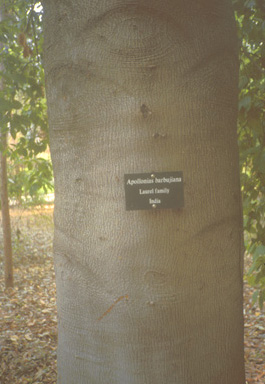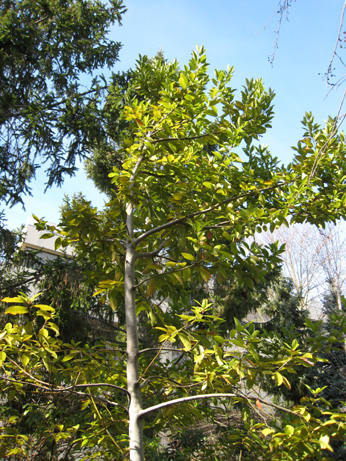Plant of the Month: January 2008
|
| Barbujana Laurel |
| Apollonias Barbujana (Cav.) Bornm. 1903 |
| = Apollonias canariensis (Willd.) Nees 1836 |
| = Laurus Barbujana Cav. 1801 |
| = Laurus Barbusano Hochst. ex Webb & Berth. 1836 |
| = Laurus Barbusana Lowe 1831 |
| = Laurus canariensis Willd. 1809, non Webb & Berth. 1836 |
LAURACEÆ; Laurel Family
|
| Most trees from the Canary Islands are cold-tender --such as the Canary Island Date Palm (Phœnix canariensis) and the Canary Island Pine (Pinus canariensis). This laurel, however, may prove an exception . . . |
| The genus Apollonias was likely named (in 1833) after the sun god Apollo or Phœbus of Greek mythology, associated with beauty. Barbujana Laurel is from the Canary Islands and Madeira. These volcanic islands are SW of Spain, off the NW coast of Africa. About the same latitude of Tampa, Florida. |
| It is similar to and related to the well known, much cultivated Mediterranean Bay Laurel (Laurus nobilis). Two genera even more closely related include Persea and Phœbe. It has one cousin in tropical rain forests of India, Apollonias Arnottii Nees. The scientific specific name Barbujana is based on its contemporary Canarian vernacular name "barbusano (barbuzano)." |
| It is a broadleaf evergreen tree recorded to 100 feet tall in the wild. The bark is at first smooth, then eventually rugged gray-brown. Its wood is highly valued in cabinetry, and is called Canary Ebony ("ébano canario"). The laurel-like leaves measure 3 to 7 inches long, and have a narrow translucent margin; they are fragrant when scratched; minute hair tufts are in vein axils beneath. Pale yellowish, slightly fragrant flowers are in axillary and subterminal clusters. The fruit is a dark brown-blackish berry, up to five-eighths of an inch long. As an ornamental specimen, it offers year-round aromatic foliage, the young spring growth being bright bronzy-red. It is more treelike, less shrubby, than Bay laurel. Whether it is more or less cold-hardy is not yet known. The leaves of cultivated trees will lack the galls so common on wild specimens. |
| In the wild it grows in the "Floresta Laurisilva" (laurel wood forest), declared by UNESCO in December 1999 a World Natural Heritage site. Laurisilva consists of 18 species of trees but features four trees belonging to the Laurel family: the Laurier or Loureiros (Laurus novocanariensis as of 2002; previously L. azorica), the Til or Tis (Ocotea fœtens), the Indian Bay, Madeira Mahogany, or Vinhático (Persea indica), and the Barbusano (Apollonias Barbujana). This forest is usually misty (above 85% humidity), and is found growing between 400-600 to 1,300-1,500 m elevation above sea level. It has vital importance in the island ecology. |
| As for cutlivated trees, a 1970 accession at the Los Angeles Arboretum measured (in 2007) 66 feet tall, its trunk 5 feet 5 inches in circumference (21 inches DBH). This tree has been reseeding sparingly, and some of its offspring have proven cold-hardy in Seattle. In April 2001 one such offspring about 10 years old was planted at Children's Hospital (NE of main building --at present it is only 15.5 feet tall, and wan looking as the photo shows; but it ought to perk up eventually); other specimens likely exist in Seattle, too. One at Colvos Creek nursery on Vashon Island has produced its own flowers and seeds. Additional testing is needed to determine the needs of this promising species. For example, how thirsty is it? Is it easily propagated from cuttings? |
It is currently sold mail-order by Woodlanders Nursery (www.woodlanders.net) (http://www.woodlanders.net) where $15 buys a one-gallon specimen. Colvos Creek Nursery (www.ColvosCreekNursery.com) first introduced it to commerce in the United States, in the 1980s, but at present is out of stock. The murky photo below shows the Los Angeles tree, complete with its pretty, but inaccurate label --confusing the Canary Island species with its relative from India.
Back |

L.A. Arboretum Apollonias close-up photo by ALJ
|

Children's Hospital Apollonias photo by ALJ
|
|
|

